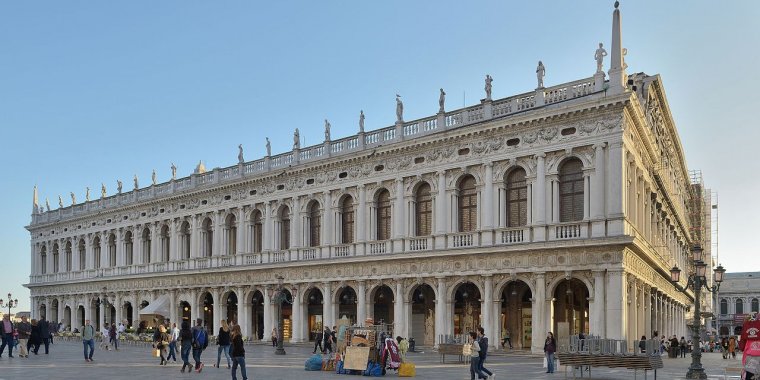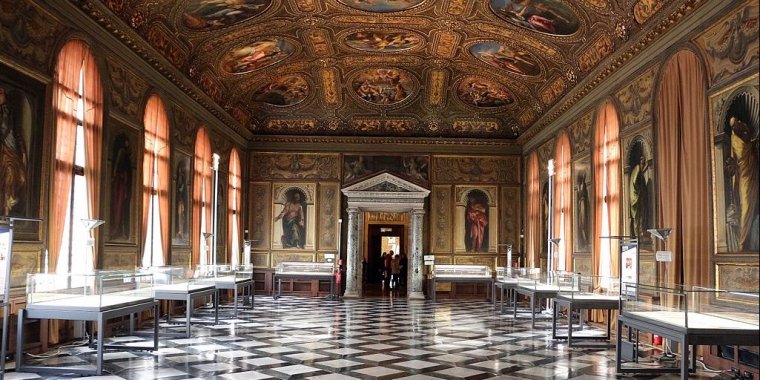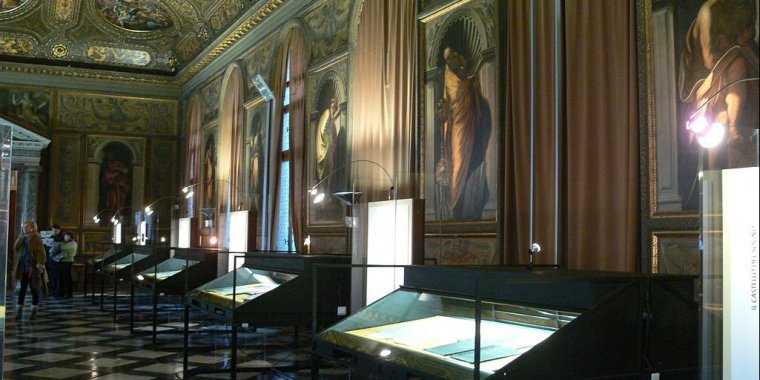| Travel / Tourist Attractions |
Biblioteca Nazionale Marciana (National Library of St Mark), Venice, Italy

Biblioteca Nazionale Marciana. ![]()
The Biblioteca Nazionale Marciana (National Library of St Mark) is a public library in Venice, Italy. Founded in 1468 as the library of the Republic of Venice, it is one of the earliest surviving public libraries and depositories for manuscript in Italy and holds one of the greatest collections of classical texts in the world. It is named after St. Mark, the patron saint of the city.
The original building, prominently located in Saint Mark's Square with the long façade facing the Doge's Palace, is the masterpiece of Jacopo Sansovino and a key work in Venetian Renaissance architecture.
The great architect Andrea Palladio considered it "perhaps the richest and most ornate building that there has been since ancient times up until now" ("il più ricco ed ornato edificio che forse sia stato da gli Antichi in qua"), and Frederick Hartt described it as "surely one of the most satisfying structures in Italian architectural history".
No less important for its art, the library houses many works by the great painters of sixteenth-century Venice, making it a comprehensive monument to Venetian Mannerism.
Today, the historical building is customarily referred to as the Libreria sansoviniana and is largely a museum. The library offices, the reading rooms, and most of the collection are housed in the adjoining Zecca, the former mint of the Republic of Venice.

Biblioteca Marciana, reading room. ![]()
The upper story of the library employs the Ionic order and is characterized by a series of “Serlians”, so-called because the architectural element was illustrated by Sebastiano Serlio in his seven-volume architectural book Tutte l'opere d'architettura et prospetiva, a guide for architects and scholarly patrons that explained the Vitruvian principles of Roman architecture.
The element, inspired by ancient triumphal arches such as the Arch of Constantine, consists in a high arched opening that is flanked by two shorter sidelights topped with lintels and supported by columns.
The ground floor is modelled on the Theater of Marcellus and the Colosseum in Rome. It consists in a series of Doric columns that support an entablature and is superimposed on a series of arches resting on pillars.
The extensive surface carvings of the façade are the work of Sansovino's collaborators, including Danese Cattaneo, Pietro da Salò, Bartolomeo Ammannati, and Alessandro Vittoria.
High-relief male allegories of generic Rivers (water flowing out of urns and cornucopias) are located in the spandrels on the ground floor with the exception of the arch in correspondence to the entry of the library which has Neptune (trident) and Aeolus (wind-filled sail).

Biblioteca Marciana - Sansoviniana wall. ![]()
The actual library was always only on the upper floor with the ground floor being let to shops and, later on, cafes as a source of revenue to the procurators. The gilded interior rooms are lavishly decorated with oil paintings by the great masters of Venice's Mannerist period, including Titian, Tintoretto, Paolo Veronese, and Andrea Schiavone.
Some of these paintings show mythological narratives, principally drawn from the writings of classical authors: Ovid's Metamorphoses and Fasti, Apuleius’ The Golden Ass, Nonnus’ Dionysiaca, Martianus Capella's The Marriage of Philology and Mercury, and the Suda.
The staircase consists of four domes (the Dome of Ethics, the Dome of Rhetoric, the Dome of Dialectic, and the Dome of Poetics) and two flights, the vaults of which are each decorated with twenty-one images of alternating quadrilinear stuccoes by Alessandro Vittoria and octagonal frescoes by Battista Franco (first flight) and Battista del Moro (second flight).
The vestibule was originally a lecture hall for the public school of Saint Mark which had been founded in 1446 to train future civil servants of the Ducal Chancery.
Beginning in 1591, the vestibule was transformed into the public Statuary Hall by Vincenzo Scamozzi in order to display the collection of ancient sculpture that Giovanni Grimani had donated to the Venetian Republic in 1587.
The adjacent reading room originally had rows of desks in the center to which the valuable codices were chained. Other books were shelved around the perimeter of the room according to subject matter. Between the windows were imaginary portraits of great men of Antiquity, the “philosophers”, each originally accompanied by an identifying inscription.
Similar portraits were located in the vestibule. Over time, however, these paintings were moved to various locations within the library and eventually, in 1763, to the Doge's Palace in order to create the wall space necessary for more bookshelves. As a result, some were lost along with all of the identifying inscriptions.
The ceiling of the reading room is lavishly decorated with 21 roundels, circular oil paintings, by Giovanni de Mio, Giuseppe Salviati, Battista Franco, Giulio Licinio, Bernardo Strozzi, Giambattista Zelotti, Alessandro Varotari, Paolo Veronese, and Andrea Schiavone.
The roundels by Bernardo Strozzi and Alessandro Varotari are replacements from 1635 of earlier roundels, respectively by Giulio Licinio and Giambattista Zelotti, which were irreparably damaged by water infiltrations. The roundels were commissioned in 1556.
The Marciana Library possesses 548 Greek codices, 337 Latin codices, and 27 incunables that once belonged to Cardinal Bessarion.
Significant manuscripts in the collection include:
• Codex Cumanicus
• Grimani Breviary of the Flemish miniaturist Simon Bening,
• Venetus A, arguably the best Illiad MS, tenth century AD
• Marcianus CCXXVIII, Aristotle
Access to the Library
Minimum age:
16 years for modern print works (after 1850)
18 years for ancient, rare and valuable manuscripts and printed books
Access to the Library is through the Orientation Office which welcomes users for the first information on the Library and issues the magnetic card, upon presentation of an identity document. Access to persons with a covered face who have not been previously identified is not permitted.
In addition, the personnel in charge of entering or issuing the access cards to the Library may request the opening of bags or containers, to carry out checks for reasons. safety.
The total capacity is 72 seats, 18 for the reading room of the manuscripts and rare and 54 for the reading room printed.
The magnetic card is issued free of charge, shows the photo of the reader, is valid for two years, is renewable and allows entry and submission of requests in the printed room.
In the event of loss or theft, the user can obtain a new card upon presentation of a receipt for payment of the issue costs, defined as 5.00 euro.
Authorization for access to handwritten and rare documents will take place, on documented grounds, in the dedicated room. In particular, students are required to submit a documentation letter from the reference professor, which certifies the research in progress.
Moreover:
Bags, backpacks, trolleys, briefcases and non-transparent containers (including laptop cases) should be deposited in the lockers at the Orientation Office (it is necessary to introduce a 1.00 euro coin for use). It is not allowed to leave objects unattended (for those who default, the sanction of temporary withdrawal of the magnetic card is foreseen).
Readers are responsible for the works received in reading until they are returned to Distribution.
It is forbidden to smoke and consume food and drink in all the rooms of the Library.
Anyone who causes damage of any kind to the works he has had in reading, trace pen marks on them, with a felt-tip pen or pencil and do not handle with due caution, following the instructions of the assistants, the volumes entrusted to him, can be excluded from the access to the Library.
Blind people have the right to enter with the guide dog in the Printed Reading Room.
Opening:
Monday - Thursday: 8.20 am - 7.00 pm
Friday, Saturday and December 24 and 31: 8.20 - 13.30
Distribution of books and manuscripts:
Monday - Thursday: 8.20 am - 7.00 pm; receipt of requests: 8.30 am - 4.45 pm
Friday, Saturday and December 24 and 31: 8.20 - 13.30; receipt of requests: 8.30 - 12.45
Direct loan:
Monday - Thursday: 8.30 - 18.30; receipt of requests until 4.45pm
Friday, Saturday and the days 24 and 31 December: 8.30 - 13.00; receipt of requests until 12.45.
(In the period 15 - 31 July of each year, the Direct Loan service is suspended in order to carry out the revision work envisaged by Article 57 of Legislative Decree 417/1995, "Regulation containing rules on state public libraries")
Interlibrary loan:
receiving requests to the Direct Loan
Bibliographic information on site:
Monday - Thursday: 8.20 am - 7.00 pm
Friday, Saturday and December 24 and 31: 8.20 - 13.30
Closing days
The Library is closed on the following days:
Every Sunday
1 and 6 January
Easter Monday
25 April
May 1
2 June
August 15th
1 and 21 November
8, 25 and 26 December
Address
Library: Piazzetta San Marco n.7 30124 Venice
Monumental Rooms: Piazzetta San Marco 13/a 30124 Venice
Sources
• www.wikipedia.org
• www.marciana.venezia.sbn.it
YOU MAY ALSO LIKE





